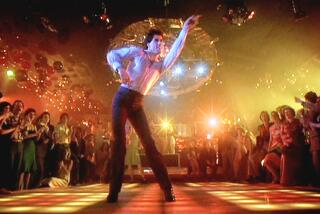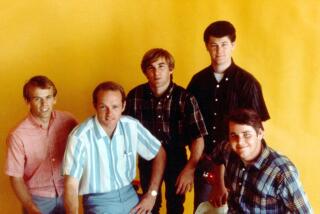Review: ‘Muscle Shoals’ on PBS’ ‘Independent Lens’
Coming to PBS on Monday via “Independent Lens,” Greg Camalier’s documentary film “Muscle Shoals” tells the story of the artists behind the artists whose names went on the label -- musicians such as David Hood, Roger Hawkins, Jimmy Johnson, Barry Beckett and Spooner Oldham, little known to most, but already legend to readers of album credits.
Set among the studios and players that turned an “undescript little town” (as local girl and Grateful Dead backup singer Donna Jean Godchaux calls it) into a recording capital, it begins, unfortunately, with a voice-over from Bono (“It’s about alchemy, it’s about turning metal, the iron in the ground, the rust, into gold”), who has surely exceeded the statutory limit on documentary appearances and is about the thousandth person you’d think of in connection with Alabama-made soul music. But Wilson Pickett’s “Land of 1000 Dances” promptly arrives to clear the palate.
In its celebration of the unsung, “Muscle Shoals” resembles “Twenty Feet From Stardom,” that movie about backup singers you have told your friends about or they have told you about and you really mean to see soon.
TV PREVIEW: Full coverage of the season’s shows
And like that film, it also tells a story of white and black musicians working together. The difference here -- in the early days, at least, when Rick Hall, the man behind the men behind the music, was cutting hits with Arthur Alexander and Percy Sledge and Aretha Franklin, before the town became a recording destination for the likes of Mac Davis and the Osmonds -- is that where “Twenty Feet” largely concerns black singers who brought flavor to white artists, “Muscle Shoals” focuses on a cadre of white musicians who worked with black singers to create a new sort of country soul music evidently irreproducible elsewhere. (The “Swampers,” as Hall’s house band was called, were assumed by many, including singers arriving to work with them at Fame Studios, to be black.)
And it’s a story, too, of young punks with ambition, and -- as Hall’s players depart to open their own studio, in competition with Hall -- of the betrayal that is growing up and moving on.
Mick Jagger (upright) and Keith Richards (slouchy) remember recording “You Gotta Move” and “Wild Horses” there. (Familiar footage from “Gimme Shelter” obligingly rolls.) Percy Sledge, Jimmy Cliff, Candi Staton, Clarence Carter, Greg Allman, Aretha Franklin, Alicia Keys are heard from, along with Johnson, Hawkins, Hood and other studio regulars; in one thrilling moment, Oldham teases from a Wurlitzer his seductive introduction to Franklin’s career-changing “I Never Loved a Man the Way That I Love You.”
First-time director Camalier wanders a bit and goes on a little long, and he gets a mite fancy with the slo-mo now and again. And, like many show business stories, his film is less interesting once everyone grows settled and successful. But he has a great central figure in Hall, whose life was marked by deprivation -- “We grew up like animals,” he says of his childhood -- and, repeatedly, by death. (He has a lot of stories.) It made him “bitter, somewhat driven -- I wanted to be special. I wanted to be somebody.” And he was.
robert.lloyd@latimes.com
Twitter: @LATimesTVLloyd
More to Read
The complete guide to home viewing
Get Screen Gab for everything about the TV shows and streaming movies everyone’s talking about.
You may occasionally receive promotional content from the Los Angeles Times.







